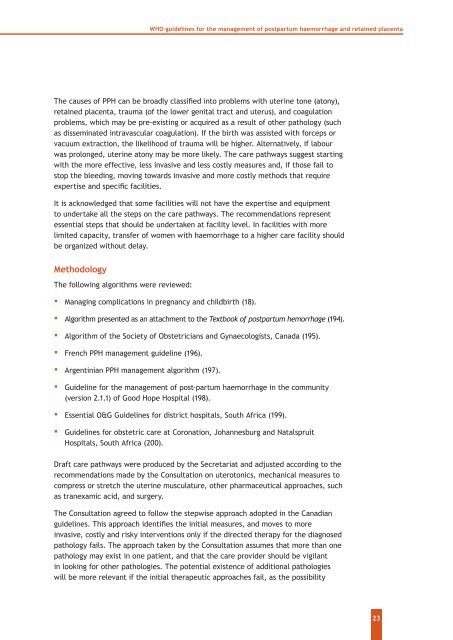WHO guidelines for the management of postpartum haemorrhage ...
WHO guidelines for the management of postpartum haemorrhage ...
WHO guidelines for the management of postpartum haemorrhage ...
Create successful ePaper yourself
Turn your PDF publications into a flip-book with our unique Google optimized e-Paper software.
<strong>WHO</strong> <strong>guidelines</strong> <strong>for</strong> <strong>the</strong> <strong>management</strong> <strong>of</strong> <strong>postpartum</strong> <strong>haemorrhage</strong> and retained placenta<br />
The causes <strong>of</strong> PPH can be broadly classified into problems with uterine tone (atony),<br />
retained placenta, trauma (<strong>of</strong> <strong>the</strong> lower genital tract and uterus), and coagulation<br />
problems, which may be pre-existing or acquired as a result <strong>of</strong> o<strong>the</strong>r pathology (such<br />
as disseminated intravascular coagulation). If <strong>the</strong> birth was assisted with <strong>for</strong>ceps or<br />
vacuum extraction, <strong>the</strong> likelihood <strong>of</strong> trauma will be higher. Alternatively, if labour<br />
was prolonged, uterine atony may be more likely. The care pathways suggest starting<br />
with <strong>the</strong> more effective, less invasive and less costly measures and, if those fail to<br />
stop <strong>the</strong> bleeding, moving towards invasive and more costly methods that require<br />
expertise and specific facilities.<br />
It is acknowledged that some facilities will not have <strong>the</strong> expertise and equipment<br />
to undertake all <strong>the</strong> steps on <strong>the</strong> care pathways. The recommendations represent<br />
essential steps that should be undertaken at facility level. In facilities with more<br />
limited capacity, transfer <strong>of</strong> women with <strong>haemorrhage</strong> to a higher care facility should<br />
be organized without delay.<br />
Methodology<br />
The following algorithms were reviewed:<br />
▪ Managing complications in pregnancy and childbirth (18).<br />
▪ Algorithm presented as an attachment to <strong>the</strong> Textbook <strong>of</strong> <strong>postpartum</strong> hemorrhage (194).<br />
▪ Algorithm <strong>of</strong> <strong>the</strong> Society <strong>of</strong> Obstetricians and Gynaecologists, Canada (195).<br />
▪ French PPH <strong>management</strong> guideline (196).<br />
▪ Argentinian PPH <strong>management</strong> algorithm (197).<br />
▪ Guideline <strong>for</strong> <strong>the</strong> <strong>management</strong> <strong>of</strong> post-partum <strong>haemorrhage</strong> in <strong>the</strong> community<br />
(version 2.1.1) <strong>of</strong> Good Hope Hospital (198).<br />
▪ Essential O&G Guidelines <strong>for</strong> district hospitals, South Africa (199).<br />
▪ Guidelines <strong>for</strong> obstetric care at Coronation, Johannesburg and Natalspruit<br />
Hospitals, South Africa (200).<br />
Draft care pathways were produced by <strong>the</strong> Secretariat and adjusted according to <strong>the</strong><br />
recommendations made by <strong>the</strong> Consultation on uterotonics, mechanical measures to<br />
compress or stretch <strong>the</strong> uterine musculature, o<strong>the</strong>r pharmaceutical approaches, such<br />
as tranexamic acid, and surgery.<br />
The Consultation agreed to follow <strong>the</strong> stepwise approach adopted in <strong>the</strong> Canadian<br />
<strong>guidelines</strong>. This approach identifies <strong>the</strong> initial measures, and moves to more<br />
invasive, costly and risky interventions only if <strong>the</strong> directed <strong>the</strong>rapy <strong>for</strong> <strong>the</strong> diagnosed<br />
pathology fails. The approach taken by <strong>the</strong> Consultation assumes that more than one<br />
pathology may exist in one patient, and that <strong>the</strong> care provider should be vigilant<br />
in looking <strong>for</strong> o<strong>the</strong>r pathologies. The potential existence <strong>of</strong> additional pathologies<br />
will be more relevant if <strong>the</strong> initial <strong>the</strong>rapeutic approaches fail, as <strong>the</strong> possibility<br />
23
















